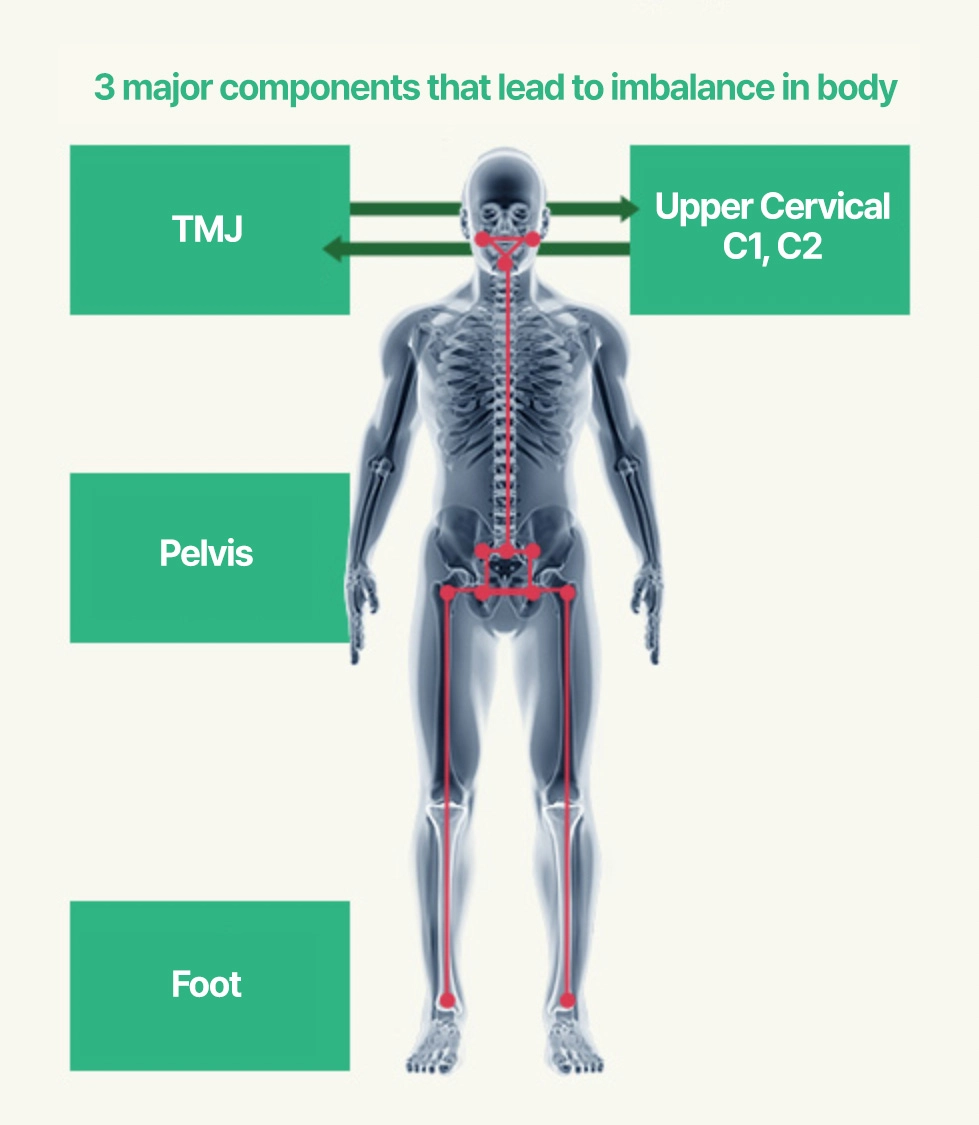Bridging Eastern & Western Medicine
MBR Clinic Utilizes Various Treatment Methods Based on Symptoms

Major contributor to migraine, neck, and shoulder pain
Occipital-Upper Cervical-TMJ Complex

The OUT complex, which includes the occipital bone, upper cervical vertebrae, and TMJ, plays a significant role in the human body’s overall balance and proper functioning of the central nervous system.
It is believed that all 12 meridians of the human body pass through the OUT complex in traditional oriental medicine. Acupuncture points located on this complex are thought to have an impact on the flow of energy or Qi through the meridians, which can help promote overall health and well-being.
Imbalances or problems with the OUT complex can result in various conditions, including craniofacial pain, migraines, dizziness, and neck and shoulder pain, emphasizing the importance of treating this complex to maintain proper body balance and health.
Correcting the Imbalance
How MBR Therapy Promotes OUT Complex Health
Acupuncture Treatment
Acupuncture is a beneficial treatment option for those suffering from tissue adhesion, knots, nerve entrapment, or myofascial adhesions as it can help to relieve tension and improve circulation in affected areas.
SOT Block Therapy
Gua Sha Treatment
Orthotics
Orthotic can be used to to correct imbalances between the left and right feet. This approach is effective for treating various conditions such as flatfoot, OX legs, anatomical short leg, scoliosis, and posture correction.
Tui Na
Tui Na is a specialized treatment technique that targets muscle and myofascial imbalances, and our practitioners at MBR ACUPUNCTURE & HERB utilize this method to achieve whole-body joint balance.
Ligament Relaxation Therapy
MBR Therapy
Correcting the Imbalance
The Importance of Muscle / Tendon Adhesion Detachment
Damaged tissue forms adhesions.
Repeated damage intensifies adhesions.
Pain with an unknown cause that cannot be diagnosed even at the hospital
Adhesion interferes with energy and blood circulations and compresses the surrounding nerves. It can cause pain, anomalies, and numbness.
Separation of the tendon adhesions is the beginning of muscle, myofascial, tendon, and ligament recovery.
Postures, habits, and movement patterns are unconsciously stored in the brain, making it challenging to fix habits at once.
Especially the way you sit on a chair, gait, or look at a computer is something that you perform countless times in everyday life and therefore exceedingly difficult to adjust.
A person cannot always maintain the correct posture or avoid movements that damage the body structure, as such, incorrect movement patterns inevitably cause pain.
The movement pattern is already memorized in the brain and cannot be easily changed, but MBR’s treatment modulates and reactivates the muscle-nerve to RE-MEMORY the new motor system in the brain.
Major contributor to migraine, neck, and shoulder pain
Kinesio Taping

Moreover, Kinesio taping aids in correcting joint misalignment, which can occur when muscles surrounding the joints are excessively tense. By directly addressing and rectifying this issue through taping, the muscles regain their natural movement, restoring the joints to their original state.

Rewiring Your Brain
Restoration Therapy Exercise
Achieving pain-free daily activities by adopting new postures, habits, and movements
How does MBR therapy modify the brain system to restore posture and movement?
Habit Transformation Program
Customized nerve-muscle exercises
Doctors often recommend exercise, but they rarely provide specific guidance on which exercises to perform and how to do them. There is no universal solution that works for everyone.
MBR’s re-memory therapy determines the appropriate exercise methods based on individual body types and in-depth analysis of muscle performance and movement patterns. As a result, even if the exercise itself is the same, the instructions vary from person to person.
Beyond muscle-focused exercise
MBR Re-memory therapy not only includes muscle strengthening exercises but also incorporates “nerve-muscle control exercises.”
Challenging yet effective exercise
However, as the patient becomes capable of executing the exercise with precision, it indicates a significant improvement in their nerve-muscle control ability, thereby preventing future pain recurrence.
